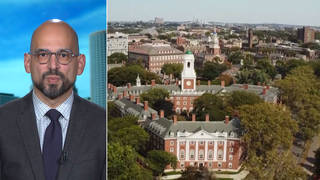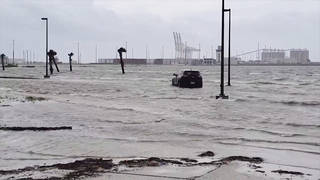
Topics
On the eve of the first anniversary of Hurricane Katrina, investigative journalist Greg Palast reports that a top hurricane expert says government officials threatened his job over his warnings about the impending disaster. [includes rush transcript]
Tomorrow marks the first anniversary of Hurricane Katrina that ravaged the Gulf Coast of Louisiana, Mississippi and Alabama. The storm was the most powerful and expensive natural disaster to hit the U.S- killing more than 1,500 people in New Orleans alone, displacing some 770,000 residents and destroying over 300,000 homes. The federal government’s response to the disaster was widely condemned–images of the tens of thousands of New Orleans residents piling into the city’s superdome stadium pleading for food, water and aid became symbolic of the government’s inaction.
In the aftermath of the storm, it become increasingly clear that the effects of Hurricane Katrina were made far worse by government incompetence and neglect. Warnings about the severity of the storm were ignored and the levees which were supposed to prevent New Orleans from flooding were grossly inadequate. And, as investigative reporter Greg Palast reveals in his new report, there were major holes in the city’s evacuation plan.
- Greg Palast, investigative reporter and author of “Armed Madhouse” reports from New Orleans. Produced by Jacquie Soohen of Big Noise Films and Matt Pascarella.
Transcript
AMY GOODMAN: Tomorrow marks the first anniversary of Hurricane Katrina, which ravaged the Gulf Coast of Louisiana, Mississippi and Alabama. The storm was the most powerful and expensive natural disaster to hit the U.S., killing more than 1,500 people in New Orleans alone, displacing some 770,000 residents and destroying over 300,000 homes. The federal government’s response to the disaster was widely condemned. Images of the tens of thousands of New Orleans residents piling into the city’s Superdome stadium, pleading for food, water and aid, became symbolic of the government’s inaction.
In the aftermath of the storm, it became increasingly clear that the effects of Hurricane Katrina were made far worse by government incompetence and neglect. Warnings about the severity of the storm were ignored, and the levees, which were supposed to prevent New Orleans from flooding, were grossly inadequate. And, as investigative reporter Greg Palast reveals in this new Democracy Now! report, there were major holes in the city’s evacuation plan
GREG PALAST: Welcome to New Orleans, whose motto is “The City that Care Forgot.” In fact, it’s a city that everyone forgot.
BROD BAGERT: Reckless negligence that killed human beings. Old ladies watched the water come up to their nose over their eyes, and they drowned in houses just like this in this neighborhood, because of reckless negligence that’s unanswered for.
DR. IVOR VAN HEERDEN: By midnight on Monday, the White House knew. But none of us knew.
PATRICIA THOMAS: Katrina didn’t come in my house and put these gates up on my windows and things. Katrina didn’t have me walking out here looking for somewhere to stay. Man did this. This was manmade.
MALIK RAHIM: They wanted them poor niggers out of there, and they ain’t had no intention to allow it to be reopened to no poor niggers, you know? And that’s just the bottom line.
GREG PALAST: Our president says he hasn’t forgotten a promise he made here.
PRESIDENT GEORGE W. BUSH: I want the people down there to understand that it’s going to take a while to recover. This was a huge storm.
GREG PALAST: Well, Mr. President, I think people down here know it was a huge storm. Over half a million of them fled the flood. It’s been a full year, and only 170,000, far less than half, have come back, almost none to their own homes.
STEVEN SMITH: Stayed three nights here and one night on the bridge.
GREG PALAST: You were three nights stuck in the flood?
STEVEN SMITH: Right here. Yep.
GREG PALAST: And they weren’t looking for you?
STEVEN SMITH: We had helicopters, but they — nothing didn’t pass. At least they passed over us. I’m on a roof, holding my shirt out and saying that we had babies back here.
GREG PALAST: This is Steven Smith. Like 127,000 others in this town, he didn’t have a car in which to escape, so he was left in the rising waters. Stranded in the heat on a bridge, he closed the eyes of a man who died of dehydration after giving his grandchildren his last bottle of water.
What kind of evacuation plan would leave 127,000 to sink or swim? It turns out that the Bush administration had contracted out evacuation planning to a corporation, IEM, Innovative Emergency Management. I couldn’t locate their qualifications, but I did locate their list of donations to the Republican Party. We went to Baton Rouge to talk to them.
These are the offices of Innovative Emergency Management. They were the ones that were paid a half-million bucks to come up with an emergency evacuation plan for the city of New Orleans before Hurricane Katrina. One problem is, I can’t find the plan. So I’m coming here to ask them about it.
So when I showed up at their office, they would only talk to me from behind a glass wall. By phone.
Did you in fact come up with a plan, because it says it’s urgent to come up with a plan? Did you come up — can you just tell me if you came up with a plan or not? I’m just happy to talk to you one-on-one. You’re probably about 12 feet away from me. Or somewhere. I don’t know, are you hiding in this office somewhere? I’m happy to speak to you face-to-face.
We can’t find your plan — neither can FEMA — that you were paid a half-million dollars for, that at least claimed to here. We can’t find this plan. And it’s kind of a problem. I guess it’s kind of hard to evacuate a city, if you can’t find the plan itself.
IEM EMPLOYEE: Can we — she’s got a lot of experience in evacuation.
GREG PALAST: Is it more true that maybe it was helpful that she gave a lot of donations to the Republican Party? Maybe that’s the experience?
IEM EMPLOYEE: Terry?
TERRY AT IEM: Yes.
GREG PALAST: So that’s when they called in the guards.
IEM SECURITY GUARD: Security has been called. We ask that you please leave the building now.
GREG PALAST: So, quickly, before security gets here, I just want to tell you that this is Innovative Emergency Management, and it’s very innovative not to have a plan to manage an emergency.
I decided to look for someone with a little more experience in hurricane evacuation. LSU, Louisiana State University, they’re just down the street from IEM. LSU has one hellacious football team. They also have the best team of hurricane experts in the nation. I met with Dr. Ivor van Heerden, deputy director of the university’s elaborate Center for the Study of Hurricanes. I asked this renowned specialist about the reputation of IEM, prior to their getting the half-million-dollar evacuation exercise contract.
DR. IVOR VAN HEERDEN: I hadn’t heard of them prior to this exercise, no.
GREG PALAST: The LSU scientist already had an evacuation model, but IEM and FEMA refused to use it.
DR. IVOR VAN HEERDEN: We had the science. We had really studied this thing. We knew what was going to go wrong. We had an enormous amount of information, right down to mapping where the gas tanks were and pipelines. Science was basically ignored all the way through the process.
GREG PALAST: The LSU professors warned, for example, that the IEM plan simply made no provision for people — the old, the sick — who couldn’t escape in a car. I asked him the consequences of this oversight.
DR. IVOR VAN HEERDEN: Well, you know, 1,500 of them drowned. That’s the bottom line.
GREG PALAST: Then the professor surprised me by saying that giving us this information put his job at risk.
DR. IVOR VAN HEERDEN: I wasn’t going to let them — let those sort of threats shut me down or any of the other sorts of nonsense that went on, because it was so important that we get out what had gone wrong and why.
GREG PALAST: Apparently, the heat from the university originated with a state official, who now works for IEM.
DR. IVOR VAN HEERDEN: We got a phone call from somebody in the state government who actually now works for IEM. But, I don’t think that was his plan at the time. And he jumped all over me and said, by criticizing their work, I was putting the whole exercise in jeopardy, and if I did it again, I would be banned.
GREG PALAST: Back in New Orleans, former city councilman, Brod Bagert, a lawyer, standing in the gutted wreckage of his own home, did not think kindly of the concealment of van Heerden’s warnings.
BROD BAGERT: Ongoing protection that should have been occurring was done — it was done negligently. Not only wrong, negligently. And not only negligently, but reckless negligence, the kind of negligence for which an individual would be indicted, prosecuted, tried, convicted, and spend their life in jail. Negligence that killed people, lots of people. Reckless negligence that killed human beings. Old ladies watched the water come up to their nose, over their eyes, and they drowned in houses just like this in this neighborhood, because of reckless negligence that’s unanswered for.
GREG PALAST: So now, we’ve discovered why there was no real plan of escape. But that leaves the question: why did the water flood the city? People drowned. The city drowned.
BROD BAGERT: Destroyed house, destroyed house, destroyed house, destroyed house, destroyed house. Every single house on every single block. Mile after mile after mile of residential urban neighborhoods are completely destroyed and remain destroyed.
GREG PALAST: Bagert took us to a neighbor’s house near the levee.
BROD BAGERT: So, look, they have three feet of mud in here. There’s a basketball. You know, some children’s toys. One day it was somebody’s home. The next day, it’s — looks like a mad monster came through it, a beast.
GREG PALAST: There’s an x on this house. It has a five under it. That means that five corpses were pulled out of here, five people who were killed. And they weren’t killed by Katrina. They were killed by this, a levee, which was supposed to protect them from the waters of the Mississippi, and it failed. And they never told the five in there that they knew it would fail.
DR. IVOR VAN HEERDEN: FEMA knew at 11:00 on Monday that the levees were breached. At 2:00, they flew over the 17th Street canal and took video of the breach. By midnight on Monday, the White House knew. But none of us knew.
GREG PALAST: Back at LSU, van Heerden’s experts warned the Bush administration about levees, long before Katrina hit.
DR. IVOR VAN HEERDEN: I, myself, briefed many, many senior federal officials, including somebody from the White House.
GREG PALAST: Without the warning that the levees had begun to break, evacuations stopped, until it was too late. But those that survived, where were they? This city is still half empty.
AMY GOODMAN: Investigative journalist Greg Palast. This piece was produced by Jacquie Soohen of Big Noise Films. Part two in a minute.
[break]
AMY GOODMAN: Hurricane Katrina flooded 80% of New Orleans, destroying the city’s infrastructure, displacing most of its residents. A year later, only about half of New Orleans population of 450,000 people has returned. Many of those unable to come back are poor and African American. In the ravaged, mostly Black neighborhood of the Lower Ninth Ward, only 1,000 of the 20,000 people who lived there before Katrina have returned. This has drastically altered the demographics of a city that used to be two-thirds Black. Activists and residents have condemned the government’s refusal to reopen the city’s public housing projects and point out that while tourist areas are being developed, affordable housing is not being built. Many are asking, “Who is New Orleans being rebuilt for?” Here again, investigative reporter Greg Palast, from New Orleans.
GREG PALAST: We drove back to New Orleans to find out what happened to those who tried to return.
What’s wrong, now?
DISPLACED NEW ORLEANS RESIDENT: They just messing all over us?
GREG PALAST: What are they doing?
DISPLACED NEW ORLEANS RESIDENT: Putting you out your own house. Now we ain’t got nowhere to go. You called them back, saying we could come back home. Then when we get there, they got the police coming in there putting us out and others. They’re harassing us. Oh no, this is not right. I’m basically between here and Texas, coming in — you know, coming to see if I could get my house back. And I’m — you know, but I’m in Texas, but I’m coming down here to see about my house. But they say they ain’t letting nobody in and all this. But where we going to go at, though? Where’s we going to go at?
GREG PALAST: What happened?
PATRICIA THOMAS: And then they told us to come back.
GREG PALAST: What happens tonight? Where are you going to go tonight?
DISPLACED NEW ORLEANS RESIDENT: That’s what I want to know, mister. I don’t know where I’m going, me and my kids.
GREG PALAST: Her friend, Patricia Thomas, was also locked out of her home in the Lafitte housing project. The next day, we helped her break into her apartment, barred by metal plates.
PATRICIA THOMAS: This is my porch, right here. I think I might take me a little break and sit on it for a minute. Yeah, this is my porch here.
GREG PALAST: The city has sealed up almost all public housing. But these apartments were never touched by water. It was nearly perfect.
And this, it’s been a year.
PATRICIA THOMAS: It’s been a year, and my house looking good like that.
GREG PALAST: I think you and I together, just the two of us, could put your place back together in a week.
PATRICIA THOMAS: You see?
GREG PALAST: No problem.
PATRICIA THOMAS: No problem at all.
GREG PALAST: But they won’t let her in. And this has nothing to do with Katrina.
PATRICIA THOMAS: Katrina didn’t do this. Man did this. Katrina didn’t come in my house and put these gates up on my windows and things. Katrina didn’t have me walking out here looking for somewhere to stay. Man did this. This was manmade.
GREG PALAST: This is not what we think of as public housing in America. These places are gorgeous, two- and three-story townhouses with iron porticos. Why would the city spend thousands of dollars per unit to armor these places, kick out the tenants? Well, the answer may be over here. This is the downtown business district. We are halfway between there and the tony French Quarter. In other words, this is some very expensive real estate. For years, the city and speculators have been trying to get the tenants out of these apartments. Katrina, the perfect storm, was the perfect excuse. So what kind of New Orleans do they want?
WHITE TOURIST: Would you like a beer?
GREG PALAST: This is the new New Orleans, stripped down, downsized, not too Black, just right for tourists. You could call it Six Flags over Louisiana.
They call this drink a “hurricane.”
But across the Mississippi, far from the Quarter, not everyone is thrilled with this brave new New Orleans of tourists and Mardi Gras.
MALIK RAHIM: It’s two cities. You know? There’s the city for the white and the rich. And there’s another city for the poor and Blacks. You know, the city that’s for the white and rich has recovered. They had a Jazz Fest. They had a Mardi Gras. They’re going to have the Saints playing for those who have recovered. But for those who haven’t recovered, there’s nothing.
GREG PALAST: Malik Rahim is a leader of Common Ground, a grassroots recovery organization. He explains why Patricia and others are locked out of their apartments.
MALIK RAHIM: They didn’t want to open it up. They wanted them closed. They wanted them poor niggers out of there, and they ain’t had no intention to allow it to be reopened to no poor niggers, you know? And that’s just the bottom line.
GREG PALAST: Malik’s group isn’t waiting on George Bush to get around to housing the surviving poor.
MALIK RAHIM: This is a unit we are getting together.
GREG PALAST: Common Ground is completing almost as many homes as the Bush administration, but who’s left? And who will stay?
This is the Lower Ninth Ward, or I should say “was” the Lower Ninth Ward, an African American working class neighborhood. There’s no potable water here. There’s no electricity. There’s no nothing. There’s just no way to return, and a lot of residents feel that’s exactly the plan.
This is Mr. Henry Irving, Sr. He has no neighbors, no water, no electricity, but he is not leaving.
HENRY IRVING, SR.: They want you to leave. That’s what they want us to do. They want us to get discouraged and leave. So why leave? Where I’m going, then? I’m going to go to another community? I put all my life in this community. I’m going to stay here, and if God’s willing, I’m going to be here long enough to see it come back.
GREG PALAST: So can it happen again? Another hurricane? Another flood? Don’t worry, because the government has hired a consulting firm to analyze what went wrong with the response to Katrina. It’s a little firm from Baton Rouge called Innovative Emergency Management.
AMY GOODMAN: Investigative reporter Greg Palast in New Orleans with producer Jacquie Soohen of Big Noise Films.













Media Options